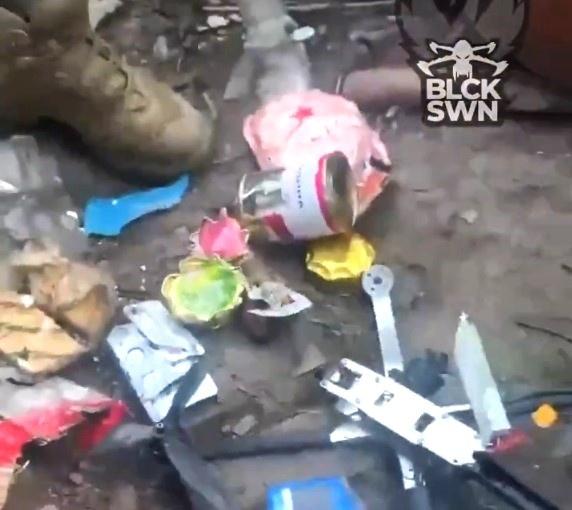The captured drone was loaded with food, coffee and tablets.
Black Swan Group
In Chasiv Yar, a battleground town in eastern Ukraine that has been under Russian attack for four months, drones are a vital source of supplies to fighters on the front line — not just for the defenders, but also for Russia, whose supply lines are constantly under drone attack.
The same small FPV drones used to destroy tanks and fighting positions appear to be being repurposed as logistics carriers.
express
The 225th Brigade's Black Swan Strike Group recently released a video on its Telegram channel with the following caption:
The cargo was attached to the drone in a cylindrical package wrapped in cardboard and plastic.
Black Swan Group
“Around the world, companies like Amazon and Google are actively testing door-to-door delivery. But in Çaşibyar, this delivery method is already mainstream and, moreover, we are using the system to compete with our competitors.”
The package contained painkillers and heartburn tablets.
Black Swan Group
The video shows Ukrainian soldiers opening a parcel attached to what appears to be a Russian FPV drone. The top item, wrapped in plastic and protected by cardboard, is a packet of Russian-made Italica brand instant coffee. Below that are several foil containers resembling those found in Russian MRE ration packs, presumably containing cheese, ham, pate, and an unidentified can. According to a typical Russian military menu, this is stew or meatballs, which may be too fatty for Western palates but will still provide calories.
Also in the package are a few tinfoil tablets containing 400mg of ibuprofen painkiller and, more surprisingly, Gastal tablets for heartburn (is stew really that bad?).
Booby trap danger
While this find is intriguing, it is extremely dangerous to open. Do not try this at home. FPV drones are frequently rigged with bombs, and both sides strongly advise against attempting to pick up downed enemy drones.
The Joker FPV is equipped with a tamper-proof fuse that will detonate if the warhead is disturbed.
Russian Ministry of Defense
Russia's Joker FPV comes standard with an anti-jamming fuse that will turn it into a bomb if the drone does not detonate during its mission. Other drones have a delay of an hour or more and are reported to detonate if taken away for analysis or reuse. Other drone detonators are equipped with magnetometers so that simply approaching a downed drone with a metal object, such as a rifle, will detonate the warhead.
Black Swan Strike Group has extensive experience using drones and an impressive combat record, and we can assume that they were aware of the risks and followed proper safety procedures when conducting this analysis.
The package in this video could easily have contained explosives capable of blowing off limbs or worse. The Trojan horse is an old ploy, but it can still work.
Logistics in the 21st Century
We've seen Ukrainian drones delivering bottled water before. Water is needed far more urgently than food, and water carriers have long accompanied soldiers on the front line. Drones can also be used for emergency deliveries of medical supplies, radio batteries, ammunition, and more. But here the drones are delivering what appear to be regular, non-urgent food.
A typical MRE package weighs about 2-4 pounds, roughly the payload of an FPV drone, and contains roughly a day's worth of supplies for one person. Unless you happen to be a single person, such as a guard or sniper at a remote outpost, you'll need multiple drone deliveries each day to keep supplies flowing.
This suggests that FPV drones are plentiful enough to be used for low-value deliveries. Ukraine has also used FPVs as bombers with drop mechanisms, but in this case the package appears to simply be taped to the drone. The drone would either remain with the recipient until it was returned, or the drone pilot would have to wait until the delivery was received and the package detached before flying the drone again.
Either way, using FPV for routine resupply suggests there is a low risk of jamming or other interference. Given that the drone was shot down, their confidence was misplaced.
Last-mile logistics are a major issue in the conflict, with every movement monitored by surveillance drones and FPV attacks common. A series of videos shows a Ukrainian drone attack on a Russian UAV-452 “Loaf” van entering the front line.
In recent months, both sides have begun to use unmanned aerial vehicles for logistics. Drones are clearly well suited to transporting high-value or emergency supplies. The Wild Hornets recently showed an interesting example, using a larger Queen Hornet FPV with a 15-pound payload to deliver a smaller FPV to the drone operator.
Small quadcopters are used for reconnaissance, directing artillery fire, bombing, laying mines, and now delivering food. More drones mean more capacity and more airdrops, straining other modes of transporting supplies. Google and Amazon may not be able to deliver goods by drone just yet, but soldiers could soon be relying on drones to get their morning coffee.



